_______________________
II-VI A&D's fiber positioners have many applications including:
- Active and passive imaging
- Laser manufacturing
- Beam shaping
- Surveillance
- Directed Energy
- Laser communications
- Tracking
- Remote sensing
- Lidars

_______________________
The first commercially available fiber-array adaptive laser beam transmitter system. The INFA is composed of a densely-packed array of adaptive fiber optic collimators for coherent and incoherent beam combining. INFA key features and benefits:
- Compact, lightweight and scalable output power and aperture size
- Output power per fiber collimator up to 10 W
- Adaptive mitigation of turbulence induced phase aberrations
- Hardware and software flexibility

Intelligent Fiber-Array Laser Beam Transmitters
In response to increasing demand for laser transmitter systems (laser beam-forming telescopes or beam directors) for various applications, II-VI's team developed the Intelligent Fiber Array (INFA) product line – first commercially available fiber-array-based adaptive laser beam transmitter systems. The INFA laser beam transmitter is composed of an array of densely-packed fiber collimators with capabilities for coherent and incoherent beam combining. The fiber arrays operate in CW or pulse regime with capability for transmitting up to kW optical power through a single fiber collimator (subaperture). Among key advantages of these systems are compactness, lightweight and scalability in respect to the output power and the transmitter aperture size. The INFA systems have build-in capabilities for electronic precision pointing and re-focusing of the outgoing combined beam, compensation of mechanical and acoustic jitter, and adaptive mitigation of atmospheric-turbulence-induced and/or thermal-convection-induced phase aberrations. The INFA systems have numerous civilian and defense applications and are considered as an attractive alternative to the existing laser beam transmitter telescope systems based on monolithic-aperture optics.
II-VI’s INFA coherent laser beam transmitter systems can be composed of different number of fiber collimators with built-in capabilities for adaptive wavefront phase piston and tip and tilt control at each fiber-collimator subaperture. In these systems, multi-channel fiber-integrated phase shifters are used for the target-plane phase locking (coherent combining) of the transmitted laser beams as well as for the pre-compensation of atmospheric-turbulence-induced piston-type phase aberration components. In addition, fast, controllable x and y displacements of the fiber tips in the fiber-collimator array provide unique capabilities for adaptive compensation of tip and tilt phase aberration components at each subaperture. Custom configurations of the INFA systems can also include an additional control system for equalization or control of the power transmitted by each fiber collimator. All three control systems are based on the advanced stochastic parallel gradient descent (SPGD+) optimization technique.
Among the key advantages of the INFA are:
- Compact, lightweight and robust.
- Scalable design in both output power and the transmitter aperture size enabled by modular construction.
- Built-in capabilities for electronic precision pointing and re-focusing of the outgoing combined beam.
- Compensation of mechanical and acoustic jitter.
- Adaptive mitigation of atmospheric-turbulence-induced and/or thermal-convection-induced phase aberrations.
INFOCO TX
Optical beam collimation, pointing, steering, automatic stabilization and adaptive tip, and tilt control – all in a single compact module. INFOCO TX offers many features and benefits including:
- High optical quality collimation of laser beam emerging from a fiber tip.
- Automatic fast stabilization of the transmitted beam optical axis in harsh operating conditions.
- Programmable rapid fine pointing and steering of the transmitted beam utilizing piezo-actuators.
- User specified optical parameters including fiber type, wavelength, and output beam characteristics.
- Controlled with the INFOCO CU(controller unit).
The INFOCO TX is an intelligent fiber-optic collimator with integrated piezo-actuators providing high-precision and high-speed fiber-tip position control.
Integrating the compact INFOCO TX module with the INFOCO CU proprietary feedback control unit offers unique capabilities for adaptive control of a transmitted optical beam.
- Free-space laser communications
- Compensation of mechanical and/or acoustical jitter
- Adaptive pre-compensation of random wavefront tip/tilt aberrations induced by refractive index fluctuations
A compact intelligent fiber-optic ultra-high performance device, the INFOCO TX is an optimal replacement of bulky, heavy and expensive conventional beam steering and adaptive tip/tilt phase aberration compensation systems. The INFOCO TX is uniquely suited to hazardous environments, e.g. vibration, acoustic noise, thermal deformation, or atmospheric turbulence.
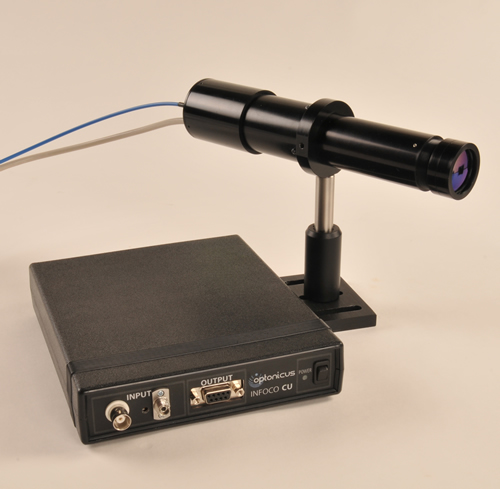

Precision pointing
The INFA system provides capabilities for precision pointing of the outgoing combined beam, for compensation of mechanical and acoustic jitter, and for adaptive mitigation of turbulence-induced phase aberrations.
Multiple applications
- Laser beam projection
- Free-space laser communications
- Smart optical sensing
- Active illumination
- Active imaging
- Laser tracking
- Remote sensing
- Beam control
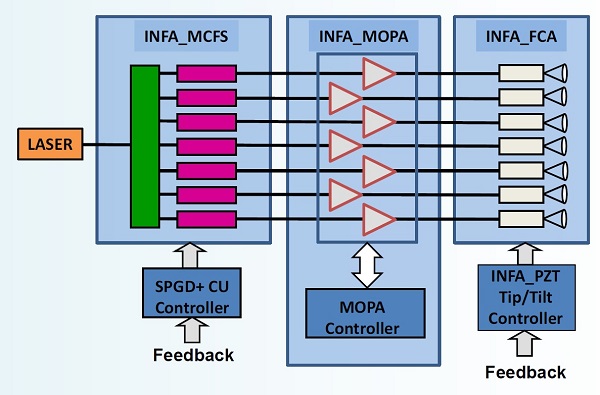

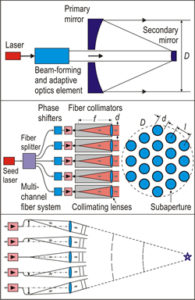

Laser transmitter system based on a conventional beam-forming telescope with adaptive optics system (top) and on an array of fiber amplifiers and phase-locked fiber collimators composed of 19 sub-apertures of diameter d and distance l between fiber-collimator optical axis (middle). Notional schematic illustrating beam focusing in a fiber array performed by fiber tip displacements is shown at the bottom picture.
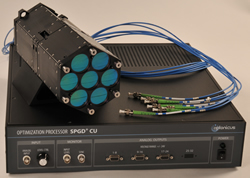

II-VI A&D’s INFA_7C, coherent laser beam transmitter system composed of seven fiber collimators together with the INFOCO SPGD+ controller. Phase-locking performance of the system has been tested in target-in-the-loop experiments over 7-km atmospheric path. Testing demonstrated the INFA system capabilities for mitigation of both the mechanical jitter and atmospheric aberrations in realistic operational conditions. The phase locking was performed through the adaptive control of local piston phases with the INFOCO SPGD+ controller.
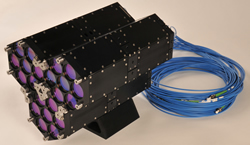

II-VI A&D's most recent INFA_21C, coherent laser beam transmitter system composed of 21 total fiber collimators grouped together into a “cluster” constructed from 3 INFA_7C laser transmitters. Based on this scalable technology, even larger systems with greater numbers of fiber collimators are under development.
II-VI A&D’s fiber-array laser beam transmitters vs. conventional beam director systems
- II-VI's fiber-array laser beam directors of various aperture sizes are assembled using identical building blocks – INFOCO transmitters. This eliminates the need for designing and manufacturing a new beam-forming telescope for every application. A new laser beam transmitter can be assembled simply by reusing the existing fiber-collimator components.
- Being composed of relatively small-sized fiber collimators, a large-aperture INFA laser beam transmitter can be significantly lighter than the equivalent conventional system based on the beam-forming telescope with monolithic optical elements. Consequently, the INFA systems can be integrated on a lighter and more precise gimbals for beam pointing and tracking.
- In conventional beam-forming telescopes, outgoing beam focusing (projection) is performed using mechanical displacement of an optical element (commonly the telescope’s secondary mirror) along the optical axis. This results in relatively slow (from hundreds of milliseconds up to several seconds, depending on the telescope size) transmitter system refocusing. In the fiber-array systems, outgoing beam refocusing is performed by tilting wavefront phase of the outgoing beams (beamlets) at the fiber-collimator system pupil. This allows on the orders of magnitude faster re-focusing of the outgoing beam.
- Fast (> 5 kHz) control of wavefront phase tip and tilts allows efficient suppression of the outgoing beam jitter resulting from mechanical vibrations – a well-recognized shortcoming of conventional beam directors.
- II-VI's fiber-array systems are robust to element failure which is especially important for system operation in hazardous environments.
- With II-VI’s fiber-array laser transmitter systems, atmospheric-turbulence-induced phase distortions can be efficiently pre-compensated using adaptive optics (AO) control of piston and tip and tilt phase components at each fiber collimator. In the INFA systems, the piston phase control is based on super-fast fiber-integrated phase shifters. This allows achieving > 15 kHz closed-loop bandwidth – the performance that cannot be achieved in the laser beam director systems based on monolithic optics and conventional adaptive optics hardware (deformable mirrors).
To learn more, see special issue on Laser beam combining and fiber laser systems,IEEE J. Sel. Top. Quantum Electron., vol. 15, no. 2, pp. 237–470, 2009.
